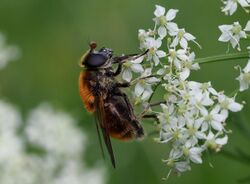Biology:Cheilosia chrysocoma
| Cheilosia chrysocoma | |
|---|---|

| |
| Scientific classification | |
| Kingdom: | |
| Phylum: | |
| Class: | |
| Order: | |
| Family: | |
| Subfamily: | |
| Tribe: | |
| Genus: | |
| Species: | C. chrysocoma
|
| Binomial name | |
| Cheilosia chrysocoma (Meigen 1822)[1]
| |
Cheilosia chrysocoma is a European species of hoverfly.[2]
Description
External images
For terms see Morphology of Diptera
The wing length is 8-10·25 mm. Wing cross veins darkened. Antennae with third segment brownish-red to yellowish-red and squarish above at the tip and the arista almost bare. Face with a small and rounded central knob situated lower than is usual in Cheilosia. Abdomen with conspicuously bright foxy-tawny pubescence. Mimics Osmia (Apidae).
[3]
[4]
[5][6]
Distribution
Cheilosia chrysocoma is a Palearctic species.[7] North Europe and Central Europe East to Russian Far East and Siberia.[8]
Biology
The habitat is wetland and Alnus and Salix woodland. Fen carr and alluvial softwood forest. Along tracks and in glades, on low-growing vegetation in the sun. Flowers visited include Caltha, Crataegus, Narcissus, Prunus, Ranunculus and Salix.[9] [10] Females have been seen egg-laying on Angelica sylvestris which may be the larval host plant. Flight period is April to June.
References
- ↑ Meigen, Johann Wilhelm (1822). Systematische Beschreibung der bekannten europäische n zweiflugeligen Insekten. Hamm: Dritter Theil. Schulz-Wundermann. pp. x, 416, pls. 22–32. https://www.biodiversitylibrary.org/item/49298#page/7/mode/1up. Retrieved 14 April 2019.
- ↑ Stubbs, Alan E.; Falk, Steven J. (1983). British Hoverflies: An Illustrated Identification Guide (2nd (revised) ed.). British Entomological & Natural History Society. p. 271, xvpp. ISBN 0-9502891-3-2.
- ↑ Van Veen, M. (2004) Hoverflies of Northwest Europe: identification keys to the Syrphidae. 256pp. KNNV Publishing, Utrecht.
- ↑ Van der Goot,V.S. (1981) De zweefvliegen van Noordwest - Europa en Europees Rusland, in het bijzonder van de Benelux. KNNV, Uitgave no.32: 275pp. Amsterdam.
- ↑ Bei-Bienko, G.Y. & Steyskal, G.C. (1988) Keys to the Insects of the European Part of the USSR, Volume V: Diptera and Siphonaptera, Part I. Amerind Publishing Co., New Delhi. ISBN:81-205-0080-6.
- ↑ Coe, R.L. (1953) Diptera: Syrphidae. Handbks.ident.Br.insects, 10(1): 1-98. R.ent.Soc.London. pdf
- ↑ Fauna Europaea
- ↑ Peck, L.V. (1988) Syrphidae. In: Soos, A. & Papp, L. (eds.) Catalogue of Palaearctic Diptera, 8: 11-230. Akad.Kiado, Budapest.
- ↑ de Buck, N. (1990) Bloembezoek en bestuivingsecologie van Zweefvliegen (Diptera, Syrphidae) in het bijzonder voor België. Doc.Trav. IRSNB, no.60, 1-167.
- ↑ Speight, M.C.D. (2011). "Species accounts of European Syrphidae (Diptera)". Syrph the Net, the Database of European Syrphidae 65: 285pp. http://www.diptera.info/downloads/StN_Species_Accounts_Glasgow_2011.pdf.
External links
Wikidata ☰ Q10745958 entry

